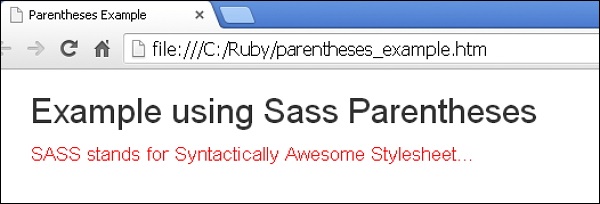
- Sass - Home
- Sass - Overview
- Sass - Installation
- Sass - Syntax
- Using Sass
- Sass - CSS Extensions
- Sass - Comments
- Sass - Script
- Sass - @-Rules and Directives
- Control Directives & Expressions
- Sass - Mixin Directives
- Sass - Function Directives
- Sass - Output Style
- Extending Sass
Sass - Parantheses
Description
Parentheses are a pair of signs, which are usually marked off by round brackets ( ) or square brackets [], providing symbolic logic that affect the order of operations.
Example
The following example demonstrates the use of parentheses in the SCSS file −
<html>
<head>
<title>String Operations</title>
<link rel = "stylesheet" type = "text/css" href = "style.css" />
<link rel = "stylesheet" href = "https://maxcdn.bootstrapcdn.com/bootstrap/3.3.5/css/bootstrap.min.css">
<script src = "https://ajax.googleapis.com/ajax/libs/jquery/2.1.3/jquery.min.js"></script>
<script src = "https://maxcdn.bootstrapcdn.com/bootstrap/3.3.5/js/bootstrap.min.js"></script>
</head>
<body>
<div class = "container">
<h2>Example using Sass Parentheses</h2>
<p>SASS stands for Syntactically Awesome Stylesheet..</p>
</div>
</body>
</html>
Next, create file style.scss.
style.scss
p {
font-size: 5px + (6px * 2);
color:#ff0000;
}
You can tell SASS to watch the file and update the CSS whenever SASS file changes, by using the following command −
sass --watch C:\ruby\lib\sass\style.scss:style.css
Next, execute the above command; it will create the style.css file automatically with the following code −
style.css
p {
font-size: 17px;
color: #ff0000;
}
Output
Let us carry out the following steps to see how the above given code works −
Save the above given html code in parentheses_example.html file.
Open this HTML file in a browser, an output is displayed as shown below.

sass_script.htm
Advertisements